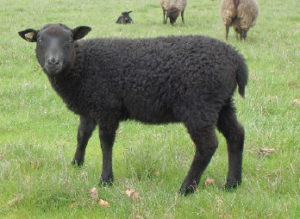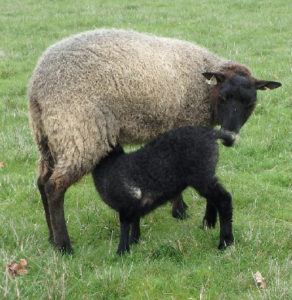Origins of Gotland Sheep
 It is believed that the breed was first established on the Swedish island of Gotland by the Vikings. They crossed the native Swedish Gute sheep with Karakul and Romanov sheep brought back from expeditions deep into Russia. The Vikings took these sheep on their travels providing their crew with meat and skins along the route. Those early travels contributed to the spread of these Northern short-tailed sheep and the development of related sheep breeds such as Icelandic, Finn and Shetland. Primitive horned Gute and Gotland sheep still exist on the island of Gotland today.
It is believed that the breed was first established on the Swedish island of Gotland by the Vikings. They crossed the native Swedish Gute sheep with Karakul and Romanov sheep brought back from expeditions deep into Russia. The Vikings took these sheep on their travels providing their crew with meat and skins along the route. Those early travels contributed to the spread of these Northern short-tailed sheep and the development of related sheep breeds such as Icelandic, Finn and Shetland. Primitive horned Gute and Gotland sheep still exist on the island of Gotland today.
Intensive and selective breeding in Sweden since the 1920’s produced the modern Gotland, famous for its soft and curly pelts. While the pelts were the most notable produce from Gotland sheep, Gotlands are a true multipurpose breed.
1. Gotland pelts – prized world-wide.
2. Gotland wool – beautiful, lusterous, purling locks for spinning and is a favorite wool of felters.
3. Gotland meat – lambs are active, quick to suckle and fast growing, reaching ideal slaughter at 5-7 months of age. The meat is mild, good flavored and close-grained.
4. Gotland sheep – robust, resilient, bright, active and friendly. They are easy to lamb, have a high lambing rate, produce abundant milk and have strong mothering instincts. Gotland sheep are very inquisitive making them an entertaining sheep breed to own. They are hardy and adaptable to a variety of management systems.
Gotland sheep are a relatively small breed making them an ideal small farm livestock alternative. They are calm and non-flighty making them the perfect breed for children and families.
The Gotlands received worldwide attention when the movie “Lord of the Rings” featured the Magic Elvin Cloaks made of Gotland wool. (Since renamed “Stansborough Grey” sheep.)
Gotland Sheep in North America
 Gotland sheep are not a rare breed worldwide but were newly introduced to North America through a cross-breeding program using artificial insemination. Artificial insemination was required as no purebred Gotland sheep existed in the United States.
Gotland sheep are not a rare breed worldwide but were newly introduced to North America through a cross-breeding program using artificial insemination. Artificial insemination was required as no purebred Gotland sheep existed in the United States.
Read about our challenges in developing the Swedish type of Gotland sheep.